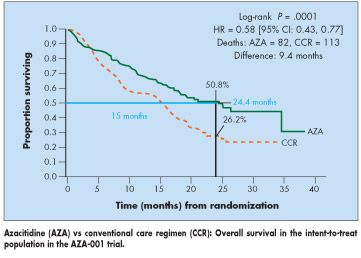Azacitidine ups overall survival in high-risk MDS patients
Results of a phase III trial show for the first time a significant survival advantage in patients with high-risk myelodysplastic syndrome who were treated with the DNA methylation inhibitor azacitidine (Vidaza). Pierre Fenaux, MD, of the Hôpital Avicenne, Bobigny, France, presented these findings on behalf of the International Vidaza High-Risk MDS Survival Study Group at ASH 2007 (abstract 817).
ATLANTA-Results of a phase III trial show for the first time a significant survival advantage in patients with high-risk myelodysplastic syndrome who were treated with the DNA methylation inhibitor azacitidine (Vidaza). Pierre Fenaux, MD, of the Hpital Avicenne, Bobigny, France, presented these findings on behalf of the International Vidaza High-Risk MDS Survival Study Group at ASH 2007 (abstract 817).

The results confirm and extend previous findings by the Cancer and Leukemia Group B (CALGB) indicating a trend toward improved overall survival with azacitidine in MDS.
This international, multicenter phase III trial (AZA-001) randomized 358 patients to azacitidine plus best supportive care (BSC) or to a conventional care regimen (CCR) plus BSC. Azacitidine was administered at a dose of 75 mg/m2/d for 7 days on a 28-day cycle.
Patients on the CCR arm were preselected by investigators to receive one of three regimens: BSC only (transfusions, antibiotics, and G-CSF for neutropenic infection); low-dose cytarabine (LDAC) 20 mg/m2/d for 14 days, every 28 to 42 days; or standard chemotherapy (Std CT) for induction/consolidation therapy.
Median follow-up for overall survival analysis (the primary endpoint) was 21.1 months.
A statistically significant increase in overall survival was observed with azacitidine, compared with CCR, with a median of 24.4 months for azacitidine vs 15 months for CCR (HR 0.58, P = .0001).
“The 2-year survival rose from 26% with CCR to 51% with azacitidine,” Dr. Fenaux emphasized (P < .0001) (see Figure).

The survival advantage was consistent across all subgroups examined, including IPSS cytogenetic group, sex, risk classification, degree of cytopenia, or proportion of bone marrow blasts; 82 deaths occurred on the azacitidine arm and 113 on the CCR arm.
All secondary endpoints examined were also superior with azacitidine, compared with CCR, including time to AML or death (13 months vs 7.6 months, P = .003); time to AML (26.1 months vs 12.4 months, P = .004); RBC transfusion independence (45% vs 11%, P < .0001); and infections requiring IV antibiotics (reduced 33% with azacitidine).
In general, azacitidine was well tolerated in this elderly patient population (median age, 69), with a safety profile consistent with that observed in previous studies of this agent. No significant increases were noted in grade 3-4 hematologic toxicities with azacitidine, compared with LDAC or Std CT.
“Azacitidine should now be considered the standard of care for all high-risk MDS patients and the comparator for evaluation of all new agents in the treatment of MDS,” Dr. Fenaux concluded.